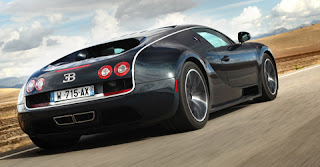Its 252-mph top speed makes it the fastest production car in the world. With 1,001 horsepower pumping from its W16 engine, it's also the world's most powerful production car. And with a price tag of about $1.5 million, it's the world's most expensive new car. For the Bugatti Veyron 16.4, everything is a superlative.
The Veyron is named in honor of a French racecar driver who won the 1939 24 Hours of Le Mans in a Bugatti -- quite the honor. Although Monsieur Veyron's namesake arrived in the world for the 2006 model year, as many car enthusiasts know, its gestation was anything but smooth. A couple years after purchasing the rights to the Bugatti marque in 1998, Volkswagen's then-boss Ferdinand Piëch announced that a road-going sports car, the Veyron, would be in production and ready for sale by 2003. Oh, and of no small matter, it was promised to be the world's fastest road-going production car ever, topping even the iconic McLaren F1.
As it later turned out, Piëch might have been dreaming a little too big for his lederhosen. The target date came and went with no car. Early Bugatti Veyron prototypes weren't ready engineering-wise and subsequently suffered a number of embarrassing public delays and gaffes. Only with a major management shuffle at Bugatti and a refocused effort on engineering did the Veyron finally come on-line.
Bugatti has said that it will build just 300 Veyrons. (What it doesn't say, and is only rumored, is that each one will be a money-loser despite the car's not-so-insignificant price.) Due to this rarity, the Veyron will be seen by few people and driven by even fewer. For the rest of us, the car of ultimate superlatives lives solely through words, pictures and grainy Internet videos.
Current Bugatti Veyron 16.4
The Bugatti Veyron 16.4 is an exotic sports car. Without seeing one in person, it's a little hard to judge the car's size, but in terms of dimensions the Veyron is actually a little bit shorter in length than a Porsche 911. To help reduce weight, carbon fiber and aluminum have been extensively utilized for the car's bodywork and structure, though the Veyron still checks in at close to 4,500 pounds.
Assigned to the task of getting that mass up to speed is a quad-turbo, 8.0-liter W16 engine mounted amidships. (The Veyron's "16.4" refers to cylinder and turbocharger count.) In simplified terms, the engine's W layout could be described as being two Volkswagen narrow-angle V8s joined together. It's rated at 1,001 hp and 922 pound-feet of torque. To put that output into perspective, think of the Bugatti Veyron as having two Corvette Z06 engines.
Power is sent to all four wheels through an F1-style, seven-speed automated manual gearbox whose design is similar to that of VW's well-regarded DSG transmission. Thanks to all-wheel drive and massive wheels and tires, the Veyron is ferociously quick, with published reports indicating a 0-60-mph time of approximately 2.5 seconds and a quarter-mile time in the low 10-second range.
And when placed into a special top-speed mode that primes the car for minimum aerodynamic drag, the Veyron is indeed capable of 252 mph. Naturally, one might find it hard to locate a long enough straight to achieve this, so Bugatti kindly limits the Veyron's normal top speed to a "mere" 230 mph.

According to those who've had the pleasure of seat time, the Bugatti Veyron is a relatively easy car to drive. Handling, though not as visceral or engaging as other exotic sports cars, is still monumentally impressive. Meanwhile, the car coddles its occupants with leather upholstery and special aluminum trim, while interior measurements are in fact quite roomy. Outward forward visibility, however, is noticeably poor due to the car's very thick A-pillars.
Past Bugatti Veyron 16.4 Models
soure:edmunds
















No comments:
Post a Comment
donot spam this site